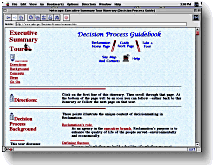Documenting Governmental Procedures On The Web
A Storyspace case studyWhen a team of technical writers at the U. S. Bureau of Reclamation (USBR) needed to document the way government agencies work and the way to get things done in government, they faced a daunting task.
| "sunsetted" -- a fine example of why documenting governmental procedures is difficult, this term refers to 'sunset regulations' that automatically phase out government programs after a fixed length of time. Originating in a political slogan of the 1980's, the term has metamorphosed into a verb and outlasted the headlines that launched it. Many readers would find this term obscure. |
|
"Decision processes are not easy, linear concepts. Steps are simultaneous and iterative. Concepts such as communication, credibility, andpriority are repeated themes throughout each step. We needed to present the decision process concepts in a useful way so readers could understand the interactions. We also needed a cheaper distribution, as groups (both within the US and overseas) were beginning to be interested." -- from "How We Did This" in the Decision-Process Guidebook |
Their first response was to create a conventional paper manual. Though the result won awards from the Burueau and from the Society for Technical Communication, the paper document still didn't meet readers' needs. In an interview with Eastgate chief scientist Mark Bernstein, one of the lead developers explained that "it became evident that a linear explanation of how government works was too convoluted and unwieldy. Readers had difficulty locating the material they needed, and the book continually repeated concepts."
To supplement the manual, the development team turned to Storyspace and the World Wide Web. "We used Storyspace to create a hypertextual space that mirrors the complex connections of governmental decision processes." In contrast to simple catalogs and news sites, the Decision Process Guidebook requires complex interconnection: its 120 Web pages are connected by over 2,000 links. Storyspace, with its graphic hypertext maps, multiple views, and convenient link tools helped the writing team design, build, and maintain this intricate web. Storyspace made it possible to see the relationships between important concepts and steps in the process. Thus, we completely re-wrote the text to fit into a hypertextual structure where readers can find what they need and see the relationships between ideas."
 Once the overall structure of the Web site had been sketched and tested, the USBR team exported the hypertext from Storyspace to HTML. After exporting the site to HTML, the designers used a variety of HTML tools to polish each page, adding graphics and refining layout to achieve the desired look.
Once the overall structure of the Web site had been sketched and tested, the USBR team exported the hypertext from Storyspace to HTML. After exporting the site to HTML, the designers used a variety of HTML tools to polish each page, adding graphics and refining layout to achieve the desired look.
The USBR Decision-Process Guidebook may be found at http://www.usbr.gov/Decision-Process.
![]()
Deena Larsen is the author of Marble Springs, Century Cross, and Samplers.

Eastgate
Fiction Nonfiction
Poetry Hypertext
Storyspace Tinderbox
HypertextNow Order

